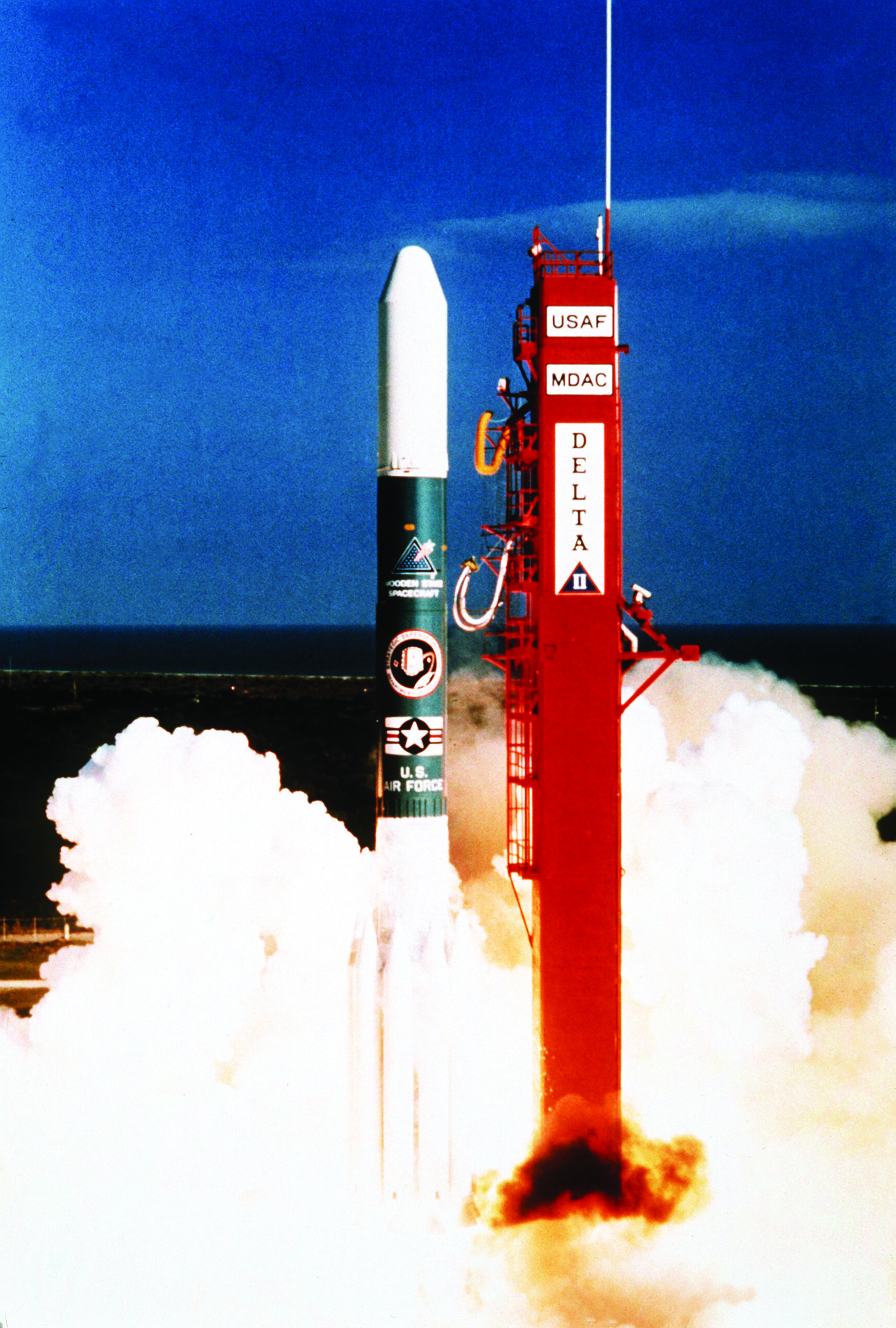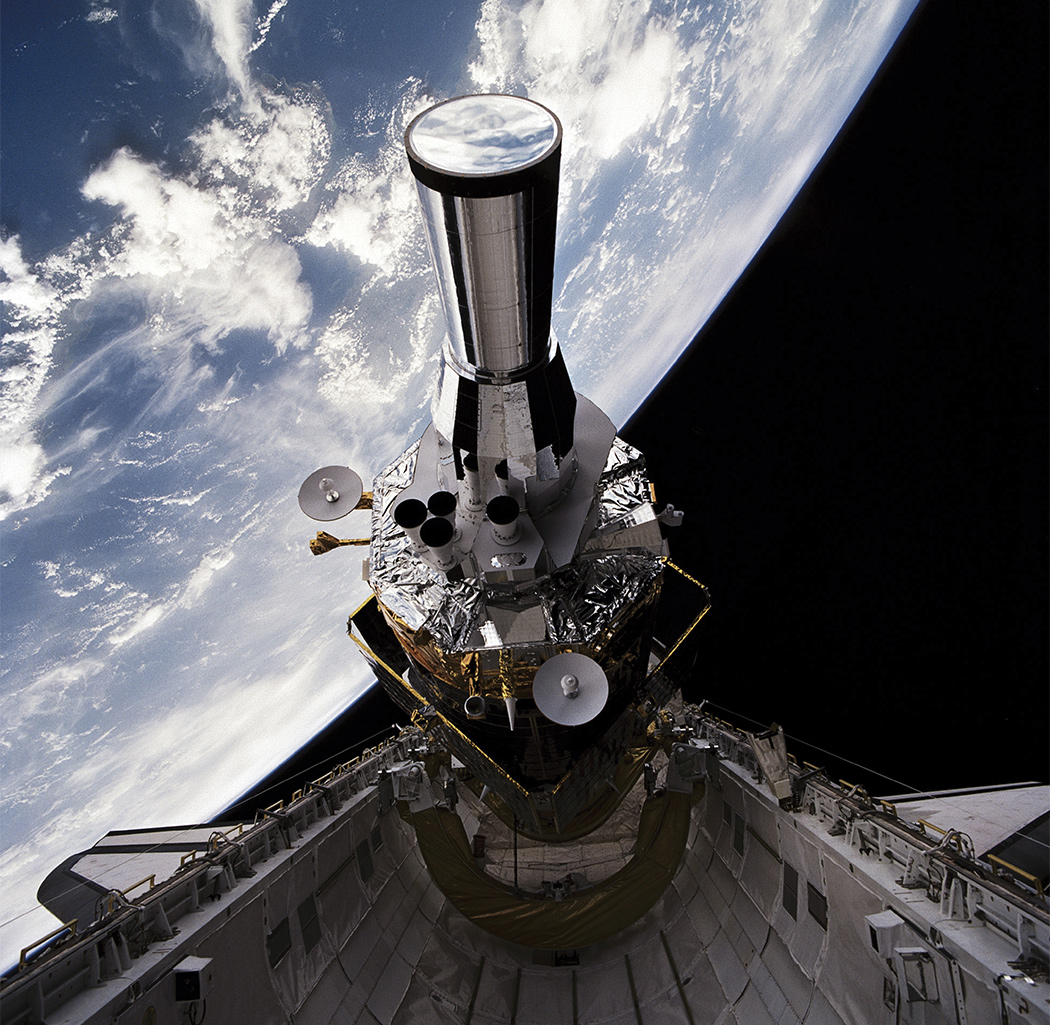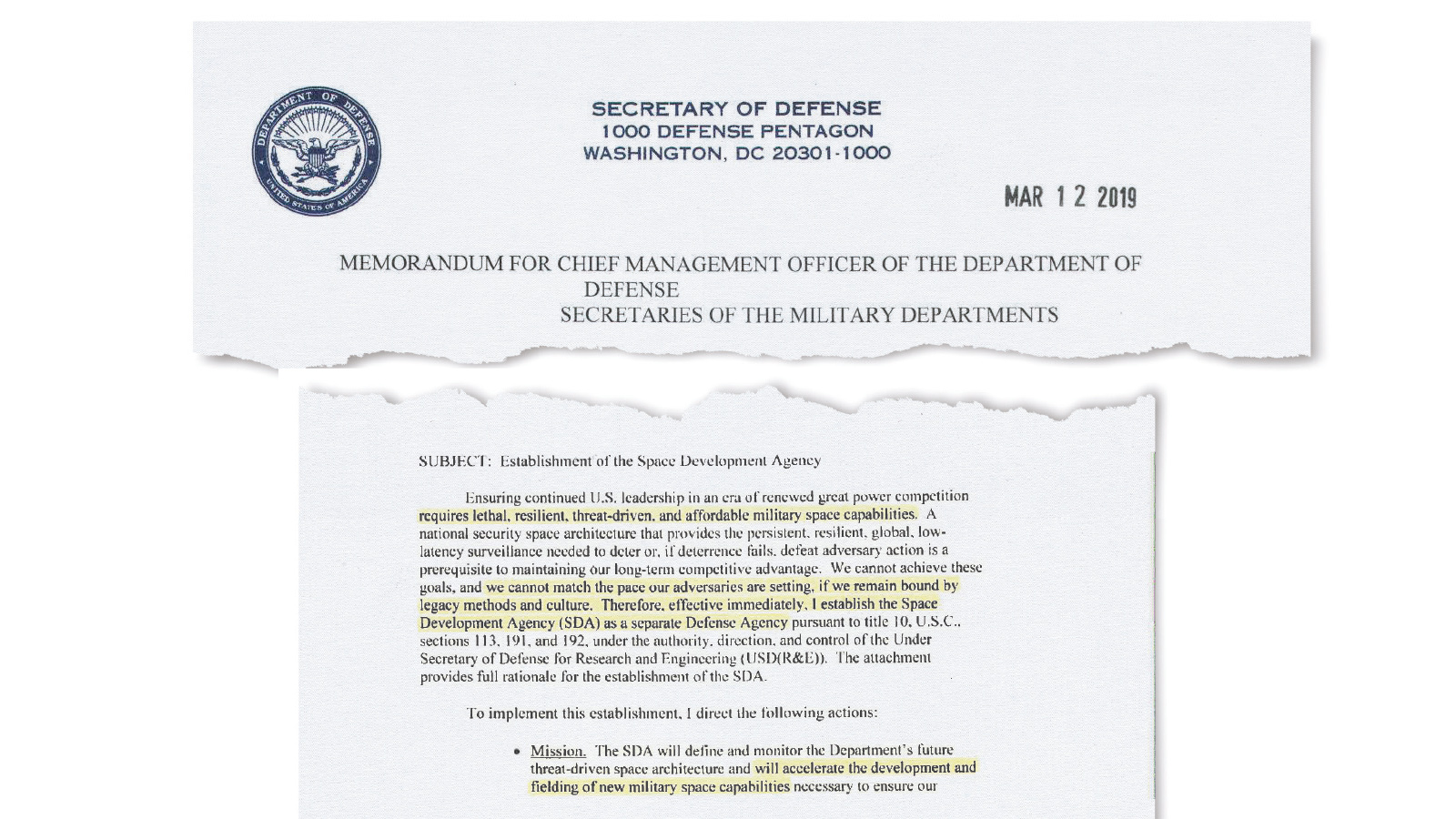Stay Up to Date
Submit your email address to receive the latest industry and Aerospace America news.
U.S. strategists once bragged about their school-bus-sized, multibillion-dollar military satellites, but now they’re worried these behemoths are a glaring vulnerability in their contingency planning for a war against China or Russia. When it comes to defending them, fresh thinking is needed. Debra Werner looks at whether creation of a Space Development Agency is the best solution.
Eleven months. That’s how long it took the Pentagon’s Strategic Defense Initiative Organization and its contractors to build and launch Delta Star, a satellite that in 1988 tested SDIO’s ability to spot rocket plumes against a complicated natural backdrop. The mission, dubbed Delta 183 for its launch vehicle, was the third space experiment launched in two years by SDIO. At the time, the Cold War was in full swing, and SDIO had a flush budget to meet U.S. President Ronald Reagan’s challenge of rendering nuclear missiles “impotent and obsolete” by showing that they could be knocked down from space.
These Delta experiments were “spawned by a rare conjunction of circumstances” that included “a major national need” and “an innovative and imaginative group of people in government, in industry,” explained SDIO’s then-director of technology, Michael D. Griffin, and his co-author in a 1990 article in Johns Hopkins APL Technical Digest.
Flash forward, and the biggest space issue for the Trump Pentagon is how to make sure that in a hot war, neither China nor Russia nor any other actor could deny the U.S. the high ground of space by hacking, blinding, disabling or destroying the country’s military satellites. A February Air Force intelligence report, for instance, concludes that Chinese military units are training with missiles built to destroy spacecraft. As for Russia, since the SDIO days and the dissolution of the Soviet Union, it has morphed into a “frenemy,” with cosmonauts and astronauts gliding by each other aboard the International Space Station, while elsewhere in orbit Russian satellites shadow those of the U.S.
One camp in the Pentagon views the situation with China and Russia as the kind of national need cited by Griffin in the 1990 article to justify creation of a separate agency. Last month, U.S. Acting Defense Secretary Patrick Shanahan established just such an organization, the Space Development Agency, under Griffin, who is now the Pentagon’s undersecretary for research and engineering.
A bureaucratic and legislative fight could lie ahead for the agency given that the first significant funding would come via the 2020 White House budget request, and elements of the Air Force have pushed back hard in private against the idea. In the meantime, Shanahan is seeking to open the office with funding reprogrammed or moved from another Defense Department account.
The agency will seek to revive fast-turnaround space projects, including “lethal” technology, Shanahan’s establishment memo says, for the new Space Force that is being set up, at least temporarily, under the Air Force.
The Defense Department last month also sent the Space Force plan to Congress.
Defense officials would not speak on the record, but one recent retiree gave a glimpse into the Pentagon’s thinking.
“We want to look at new ways of doing space missions, new ways of doing missile warning, new ways of doing communications, new ways of doing GPS,” says Doug Loverro, the former deputy assistant secretary of defense for space policy who remains in close contact with his former Pentagon colleagues.
Some in the Air Force are pushing back behind the scenes, arguing that a new bureaucracy is not the best way to do this. The bulk of U.S. military space hardware is today developed and managed by the Air Force Space and Missile Systems Center in California, and this camp believes that SMC can adapt and is, in fact, beginning to.
A dozen current and former Defense Department officials interviewed for this article did not deny that there are issues. A lumbering U.S. military bureaucracy inhibits innovation, they say. They disagree, though, about the wisdom of creating a new agency to address the problems.
If critics are right, the Space Development Agency will divert resources without producing any new satellites or networks that troops can rely on. If supporters are right, the new agency will spur innovation and lead to a new generation of satellite constellations that would be resilient against physical or cyber attacks.
No more juicy targets
The record shows that the Air Force has, in fact, been adapting its strategy in recent years. Military planners, including some in the Air Force, came to realize that the U.S. approach of relying on small numbers of extremely capable large satellites for functions such as missile warning and protected communications was risky because potential adversaries could hack, jam or destroy the satellites. A turning point came in 2017, when Gen. John Hyten, who leads U.S. Strategic Command, announced he would no longer support the development of “big satellites that make juicy targets.”
After that, the Air Force established the Space Rapid Capabilities Office at Kirtland Air Force Base in New Mexico to develop and field technologies to protect spacecraft from attack. The service also created the Space Enterprise Consortium at SMC in Los Angeles, where business people who don’t traditionally work with the federal government compete for one-page contracts to build prototype sensors, components and spacecraft.
The message? The Air Force space establishment is changing. “Standing up a new agency that lives on the Office of the Secretary of Defense staff is not a way to speed up development of space-based systems,” says retired U.S. Air Force Lt. Gen. David Deptula, who leads the Air Force Association’s Mitchell Institute of Aerospace Power Studies in Virginia.
That said, an argument against Shanahan and Griffin could prove hard to win, so Deptula has taken to airing a possible compromise. If Pentagon leaders are intent on creating a new agency, he says, they should move it inside U.S. Space Command, a joint command staffed by members of all the services that was re-established by presidential executive order in December after a 17-year hiatus. U.S. Space Command will have the most experience employing space systems, so it makes sense to house the agency responsible for rapid development there, Deptula argues.
Proponents of the Space Development Agency have no intention of embedding the organization within the Air Force, a service they charge with moving too slowly to field small satellites and with resisting bold new ideas for how to operate them.
They want to go in new directions and even unleash the pent-up talent in the Air Force and other services to help them do that. To understand where those paths might lead, Loverro challenges me to imagine a game of chess with the various pieces representing the array of commercial satellites coming onto the market that the military could purchase. Today, the Air Force looks at all the chess pieces but moves only the king, a powerful figure but one with limited mobility. The king in this analogy would be a large, expensive satellite. The Space Development Agency will consider “how to take all these pieces that have been assembled by the great entrepreneurial forces of the United States and figure out how to create new architectures,” Loverro says, using the term for the mix of kinds and sizes of satellites that constitute a constellation.
Take communications networks. For the moment, most military communications flow over giant satellites in geostationary orbit that are owned either by private companies or the Air Force or Navy. To avoid cyberattack, the military could instead create a communications network that includes commercial constellations in low Earth and geostationary orbits as well as military satellites. “Our goal should be to incorporate everything you’re doing and everything our allies are doing so this is no longer a juicy target,” Loverro told a Silicon Valley audience in October at the Satellite Innovation Symposium in Mountain View, California.
In this view, the clock is the real competitor. Like Silicon Valley, China, Russia and other potential adversaries are innovating rapidly, according to “Competing in Space,” the unclassified February report from the Air Force’s National Air and Space Intelligence Center, the one that referred to China’s anti-satellite training.
The Chinese Embassy in Washington did not respond to requests for comment about its actions and plans in space. The Chinese Academy of Sciences, however, has issued statements saying the country is intent on peaceful application of space technology.
Some are skeptical about China’s claims. “We have every reason to believe that the Chinese have offensive capabilities on orbit,” says Robert Walker, former Republican chairman of the U.S. House of Representatives Science Committee and an ally of the Trump administration. “They call them other things, but they appear to be capable of offensive operations against our space-based assets.”
Risk-averse culture
Fred Kennedy of DARPA fame is Griffin’s pick to lead the new Space Development Agency. Kennedy declined an interview request, but he has left a trail of criticism about today’s military space establishment. Speaking last August at the Small Satellite conference in Logan, Utah, Kennedy diagnosed a “risk-averse culture” that “wants to spend a lot of time fixing and testing, testing and reviewing. That’s a problem because our adversaries are figuring out how to do things more quickly, more cheaply.”
In the months leading up to Shanahan’s memo, Kennedy led a Defense Department study to define the new agency’s mission and organizational structure. Pentagon leaders do not need congressional approval to establish the new agency, but they need an appropriation. The Defense Department plans to ask Congress for $120 million to $200 million per year for the Space Development Agency.
In his years leading DARPA’s Tactical Technology Office, Kennedy has encouraged Pentagon leaders to harness commercial innovation like inexpensive small satellites.
In recent years, investors have been pouring money into commercial space technology. Venture capitalists provided $3.25 billion in 2018 to startups around the world working feverishly to build constellations of small satellites for communications and Earth observation as well as rockets, hyperspectral sensors, spaceplanes and laser communications terminals. Much of the new technology draws on mass-produced miniature electronics created for smartphones and automobiles. Many space industry entrepreneurs also have adopted the agile development approach of software suppliers. As soon as they invent new satellites, sensors or ground terminals, they look for ways to improve hardware and software.
Government space programs are completely different animals. Military planners must anticipate their needs well in advance because it may be decades before they can purchase another generation of missile warning or secure communications satellites.
Then, the government goes to its traditional stable of prime contractors and vendors whose businesses are set up to comply with complex federal acquisition rules and cost-plus contracts, meaning they can produce an audit trail for every expense. Those companies offer some of the world’s most sophisticated and expensive satellites.
“If it’s the only platform the government is going to buy for the next 10 years, that creates incentives for manufacturers to lard on as much as possible,” says Dean Cheng, a Heritage Foundation senior research fellow.
Congress also plays a role. Providing less funding in certain years than the military requests can play havoc with production schedules. Adding money to the budget for satellites the Air Force intended to stop buying can draw out subsequent programs.
Sometimes the process results in satellites launched years late and over budget. The Air Force’s Space-Based Infrared System satellites, or SBIRS, are a prime example.
In the late 1990s, the Air Force embarked on an ambitious effort to develop state-of-the-art infrared sensors for satellites in geosynchronous and highly elliptical orbit to detect and track short- and long-range ballistic missiles. At its inception in 1996, the project carried a $4.2 billion price tag for five satellites. By the time the first satellite reached orbit in 2011, nine years late, the Air Force had paid $19 billion for six satellites.
“If the precursor constellation” — the Defense Support Program satellites — “hadn’t lasted as long as it did, we would have been without a missile warning capability in space,” says a former Defense Department official.
It’s not that anyone was gold-plating the satellites or dragging out production schedules. The whole system seems designed to produce massive, expensive satellites at a snail’s pace.
“That often means [military] technology has fallen behind commercial capabilities,” says Cheng of the Heritage Foundation.
Cheap commercial satellites
The Space Development Agency, with its planned 50-person staff, is supposed to address that problem.
“I have to find a way to bring all that wonderful capability out of the private sector and into the Defense Department and the intelligence community,” Kennedy said in Utah.
One effort to do that is Blackjack, a DARPA campaign run by Kennedy’s Tactical Technology Office to develop a constellation of small inexpensive military communications and surveillance satellites and associated ground systems.
To some Air Force leaders, the idea that the U.S. military can support troops around the world with inexpensive commercial satellites is ludicrous.
“Can you imagine doing missile warning with these cheap commercial things?” asks a senior Air Force official who did not want to be identified.
Before a military satellite is approved for a critical mission, it must show it can identify specific threats and report on them within a limited amount of time with an extremely high rate of reliability. “There is a role for experimentation, but it doesn’t replace analysis and planning because it has to be integrated in operations. It has to be used,” the Air Force official adds.
True, the U.S. is not likely to rely on a commercial satellite for strategic nuclear missile warning, Loverro says, but that doesn’t mean “we can’t learn from Blackjack.” Perhaps the military will end up buying its own 1,000-satellite missile warning constellation, he adds.
Blackjack sounds like a project right out of the Strategic Defense Initiative Organization’s playbook. SDIO, precursor to the Missile Defense Agency, focused on rapid experimentation. Projects moved quickly with streamlined management. Program managers had authority to spend money and award subcontracts.
Also, SDIO wasn’t focused on technological breakthroughs. Program teams often modified existing technology to achieve 80 percent of their goals within a year instead of aiming for 100 percent in five years, says an SDIO veteran who asked not to be identified.
On Delta Star, for example, an industry team added eight spectral filters to a commercial spectral imager with no filter. While the details are classified, the experiment helped SDIO home in on the spectral signature of a booster firing.
“This work contributed to the color selections for all U.S. ballistic missile defense seeker systems,” says the SDIO veteran. “You didn’t end up building an intercept that didn’t see its target.”
Another bureaucracy
Experimentation and flight testing are valuable exercises, Air Force officials agree, but why establish a new agency for that?
“If you want an organization that can apply commercial technology and do things faster, why not do this in DARPA or the Space Rapid Capabilities Office?” asks the senior Air Force official.
The Government Accountability Office has frequently criticized military space programs, citing fragmented leadership, redundant oversight and the difficulty of coordinating work among numerous stakeholders.
The Space Development Agency will not set out to fix the military acquisition system, but rather to encourage more experimentation and risk-taking. Those who end up working for the Space Development Agency, like the people who worked in SDIO, will be focused on accomplishment, says the SDIO veteran.
Eventually, though, even the most innovative defense agency is likely to succumb to bureaucracy. “This is a government we’re talking about, and government by definition spawns bureaucracy,” Cheng says.
Pentagon makes its case
The U.S. Defense Department explained the role of the Space Development Agency in its Space Force proposal delivered to Congress on March 1.
“The Department of Defense has undertaken a series of space acquisition reforms to ensure the joint force has the capabilities necessary to deter and defeat threats. These acquisition reforms will continue with the establishment of a joint Space Development Agency (SDA) dedicated to rapidly developing, acquiring, and fielding next-generation military space capabilities. The SDA will transition into the Space Force, when established, to strengthen the foundation for space acquisition,” according to a Defense Department brochure dated February 2019.
President Trump proposed creating the Space Force, a sixth branch of the U.S. armed forces, in legislation delivered to Congress in March. While awaiting congressional approval, the Defense Department plans to set up the Space Force within the Air Force.
The Space Development Agency will start out in the Office of the Secretary of Defense under the supervision of Michael D. Griffin, deputy undersecretary for research and engineering. Griffin also oversees: DARPA; the Missile Defense Agency, successor to the Strategic Defense Initiative Organization; the Defense Innovation Unit, which applies commercial innovation to military problems; the Strategic Intelligence Analysis Cell, an organization that assesses capabilities and vulnerabilities of the U.S. and potential adversaries; and the Strategic Capabilities Office, which seeks new applications for existing weapons.
As of early March, the Pentagon was not saying where the Space Development Agency would be located. Former Defense Department officials say it’s likely to be in Washington, D.C., or northern Virginia.
— Debra Werner
“Standing up a new agency that lives on the Office of the Secretary of Defense staff is not a way to speed up development of space-based systems.”
retired U.S. Air Force Lt. Gen. David Deptula
About Debra Werner
A longtime contributor to Aerospace America, Debra is also a correspondent for Space News on the West Coast of the United States.
Related Posts
Stay Up to Date
Submit your email address to receive the latest industry and Aerospace America news.








